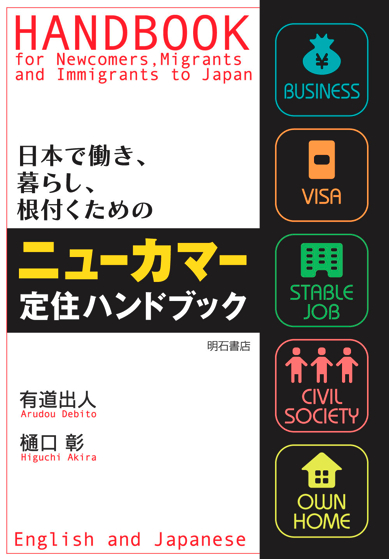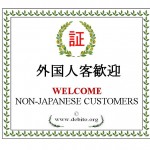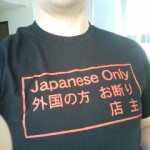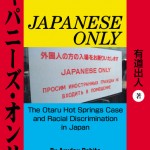mytest






![]()

UPDATES ON TWITTER: arudoudebito
DEBITO.ORG PODCASTS now on iTunes, subscribe free
Hi Blog. For a Sunday Tangent, watch what happens when an exclusionary sign goes up in, say, India. Article from the Times of India follows (of quite questionable writing quality, but never mind). More interesting than the article are the comments from readers below it online. They are not amused, indeed. Have a read. Arudou Debito in Sapporo
////////////////////////////////////////////
Sorry, Indians not allowed
Rajesh Kalra Tuesday December 15, 2009, 02:39 PM, Courtesy SH
http://blogs.timesofindia.indiatimes.com/randomaccess/entry/sorry-indians-not-allowed1
My friend Ramit (name changed on request) called me late Friday night. He sounded quite agitated. “You know, Haagen Dazs has opened its Delhi outlet”. I reacted with a joke. “Good, now you can spend a lot more on an ice cream than you normally would. But why are you agitated?”
“Because I am not allowed to enter”, he said. Now, Ramit is not like one of the politician’s son or into drugs, the sort who are often in news in India’s capital for all the wrong reasons, nor is he the kind who will shoot someone down because she refused to serve him a cone of ice cream.
He did not waste much time and said he has taken a picture and is mailing me the reason. I switched on my mail, and clicked on the attachment. I couldn’t believe what I saw. Was I in India, 62 years after gaining independence, and years after South Africa officially ended apartheid?
The banners outside the outlet said: Exclusive Preview for International Travellers. And under that, in an even finer print, the real bombshell: Access restricted only to holders of international passports.

I immediately called Ramit. “You are an international traveler, and you have a passport, so you can go in”, I said. Ramit’s response was instant: I tried to enter but they said you are not allowed for you don’t have an international passport.
I am normally not given to immediate emotional reactions, but I couldn’t resist this time. I was, to be honest, upset. How can they do this to an Indian, in India? Do a story on TOI or NBT? Do it for print or Online? Call other media friends and colleagues? I simply didn’t know how to react. Print would have a better impact, but should I wait that long?
Then I felt, why not use the power of the social media? Next thing I knew was that I had put up a few pictures on facebook, added a caption and also sent out a tweet with a request it be retweeted. In a few hours, it had turned into a viral and I started getting messages from angry Indians all over. Why just Indians, even friends in international media wrote to say “this is the stupidest thing they have seen in a long time”.
I didn’t stop at that. I ended up calling a few MPs I knew I could speak to bluntly and told them about it, taunting them about it.
I don’t know what finally worked, but it seems word did get around to the outlet’s franchisee and they started claiming there never was any restriction on anybody entering the outlet.
While this may be considered a victory for people power, I am still unable to figure out who in his right senses would have advised the dessert company to do something so stupid. Was it a way to generate controversy for free publicity? Did they think it will work subliminally on Indians mind that now that it has been ‘certified’ by international travelers it would be good for them too?
Whatever it is, it is idiotic. I checked later and found that the franchisee is an Indian company based in Delhi and the man incharge is also an Indian.
I have often maintained that we ourselves are our biggest enemies. Our mentality is that of slaves and we think anything is good only if its approved by foreigners, or the “holders of international passport”.
Perhaps the Indian franchisee had this in mind. And a comment on the picture I put up on the facebook by an Indian who migrated to Australia decades ago sums it up: Most international travellers don’t want HD in India when they can get it in their own backyard. Its a commodity not a special thing for them. They would also see this as pure cashing in and thinking they are idiots – ‘India taking them for a ride.’ Have to remember not every international traveler is American; makes an average salary of squillion dollars; can often be allergic to dairy (yes); is in India to have an ‘authentic Indian’ experience and by golly even enjoy kulfi, falooda, lassi, dosa! This is all about how India and Indians see themselves. Foreigners have nothing to do with it.
///////////////////////////////////////////
Read comments at
http://blogs.timesofindia.indiatimes.com/randomaccess/entry/sorry-indians-not-allowed1
9 comments on “Sunday Tangent: Haagen Daz ice cream excludes Indians from sampling the latest flavor — in India!”
I have been to 31 Ice Cream (Baskin Robbins) in New Delhi, and homeless kids were lined up outside in mass numbers. After going a long time without luxuries while in India, I had wanted something as a treat. Once I had purchased my ice cream though, I couldn’t bring myself to eat the ice cream with all those little, hungry kids staring at me. So of course I gave my cup away, as do many I imagine. Which possibly would explain the amount of kids at such a place. I would guess, that the large groups are a side effect of having those establishments in poorer areas. But the shops clearly they need to rethink their tactics.
I can’t believe they tried to pretend it was unintentional… it’s certianly possible for a non-native English speaker to come up with a sentence that manages to sound absolutely perfect, but miss out on a few of the nuances. But even putting the excellent English that most Indians I have met speak aside, some of those words are pretty exclusionary in AND out of context. “Exclusive”? “Restricted”? I’m pretty sure that either of those words by themselves contain an element of “keeping some people out,” regardless of which dictionary you’re using.
Hi Debito,
Unfortunately this story is true. If the world decides in any way to label us Indians bad, today only a few hundreds protest, but through technology the day is not far when there will be millions who can raise voice in a short span.
Let us admit that it was a bad business practice, worse, the choice of words was derived by an Indian only. So we can not blame it solely on Haagen-Dazs for doing it. But we have to solely blame the person who designed this marketing strategy for Haagen-Dazs.
Now coming to what Rajesh said here that “We are our own enemies…”, I have a tangent but important point to make, which is again a bad business practice in existence in India and most unfortunately it is supported by the Govt Of India – GOI itself.
You would remember that almost an year ago, I wrote to you about exceptionally high entrance fee being levied (may I use the word extorted) from foreign visitors (there, process of identifying a foreigner is by his/her facial looks / skin color only) towards entrance fees at Taj Mahal or Ellora Caves etc popular places and even sent you a picture of the ticket window as a proof of same. This is also a bad Government mentality and discriminatory practice here, which is designed by our friends only in the Archaeological society of India, right under the noses of GOI bureaucrats. I have tried to protest this issue several times in past, but no one wants to listen to it here. It wont dawn on them until the Prime Minister of India visits a place which reciprocates this Indian Practise, may I say (as an example) that in Japan, an Indian Prime Minister is charged to pay 50000 yen at Kamakura Daibutsu or Kinkakuji / Kiyomizudera, while all other Japanese Natives are being charged only 500 to 1000 yen.
To conclude, I must say, that our own Indian colleagues need to bravely fight such practices which were nothing but a poor resemblance to the early British rule. We must learn to say NO when it is needed most !
This sounds like something someone would make up as the premise of a comedy skit. I’m no marketing expert, but if this isn’t the worst business strategy and the worst public relations disaster of all time, I will give up all hope of ever becoming an entrepeneur. On the other hand, if Indians allow this to be forgotten and patronize the store when they get the chance, I suppose I will be morally obligated to move there and start a cult–if I can think up sufficiently humiliating indignities to offer my adherents.
Several years ago in the UK, a “Not For Girls” warning was printed on Yorkie candy bar packaging. The result was a minor controversy and a wee bit of media brouhaha over perceived sexists overtones inherent in the marketing campaign.
As it turns out, it was all orchestrated by PR firm Hill and Knowlton. Their website even featured the Yorkie Bar campaign as a successful “case study”. The page has since been deleted, but thanks to Internet Archive, you can still see the self-admission in all its glory:
http://web.archive.org/web/20041213143821/http://www.hillandknowlton.co.uk/case_studies_74.html
The above pictured Hagen Das sign reeks of the same “managed debate” tactics used in the Yorkie campaign.
What can I say, managed controversy means free media attention. And from what I can tell, Hagen Das got exactly what it wished.
On a side note, the Hill and Knowlton website makes for creepy reading:
http://www.hillandknowlton.com/
What George says above probably has some truth to it… but that’s even more troublesome to me than the sign itself. I know women who wear men’s cologne, just about every women I know has bought “Men’s Pocky,” etc. They’re not exactly the kind of girls who parade around Tokyo in frilly pink miniskirts, but for a certain set of women, “masculine,” “tough,” “butch,” “rebellious,” put whatever spin on it you want but being UNfeminine is a kindof fashion statement.
Is being “Un-Indian” a fashion statement in India? If so that is quite disturbing, and indicates not only a discrimination issue but SELF-deprecation… [weird tangent deleted]
Weird indeed. But the thing is, I’ve sometimes wondered how a club/bar/restaurant/business would be received here in Japan if it issued a “No Japanese” declaration. I imagined this not as a full-on (racist) policy, but as a temporary or ironic gesture, a “fight fire with fire” illustrative action designed to first draw, then shift attention to the “Japanese Only” issues that many foreign residents are familiar with. Put the shoe on the other foot and maybe a Japanese exclusion awareness would evolve, and prove cathartic.
We’re living in a funny world. In Japan, some establishments say “Japanese Only” whereas in India they say “Foreigners Only”.
This reminds me of my native Turkey. In Turkey, bars and clubs do not let single males or all-male groups in. The sign “Damsız Girilmez” (no entry without a female partner) was a staple on the doors of such venues, they’re now increasingly replaced by bouncers whom kindly shove you off using the phrase “Damsız Girilmez”. But this rule only applies to Turkish men. Foreigners have no problem entering. Another such group is the “friends of the owner” of course. Apart from this type of nepotism, the idea is “we are uncivilized people” and it’s available in our good old Third-World countries such as Turkey and India.
Well, in the West there are no signs barring entry to foreigners and minorities, but bouncers worldwide shove off people whom are not within the standards designed by the venue and these out-of-standard people may include foreigners and/or minorities. The difference is they may not put up signs as in Japan.
Again, it’s a funny world isn’t it? Some don’t want foreigners, some don’t want natives, and in between there are people like us, in a comperably small number who’d like to let everybody in.
This is absolutely ludicrous, of course. If it’s not a marketing ploy, it’s absolutely bizarre.
I must say, though, I’m a bit disappointed with your tolerating the anti-Americanism at the end of the post. Normally people get called out here for stereotyping Americans as rich, ignorant, and uninterested in local food, so I’m sad to see them all spoken of like this in the same breath.
— Well, call them out on it, then.